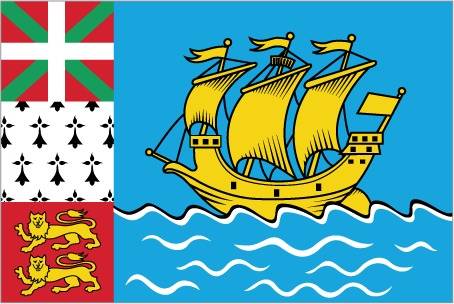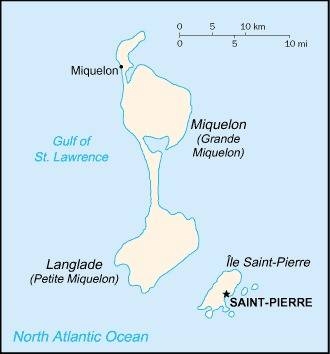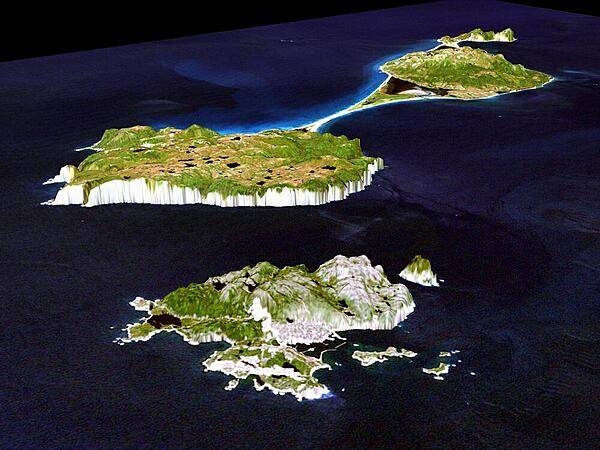77 Saint Pierre & Miquelon (France)

A yellow three-masted sailing ship facing the hoist side rides on a blue background with scattered, white, wavy lines under the ship. A continuous black-over-white wavy line divides the ship from the white wavy lines. On the hoist side, a vertical band is divided into three parts: the top part (called ikkurina) is red with a green diagonal cross extending to the corners overlaid by a white cross dividing the rectangle into four sections; the middle part has a white background with an ermine pattern; the third part has a red background with two stylized yellow lions outlined in black, one above the other. These three heraldic arms represent settlement by colonists from the Basque Country (top), Brittany, and Normandy. The blue on the main portion of the flag symbolizes the Atlantic Ocean and the stylized ship represents the Grande Hermine in which Jacques Cartier “discovered” the islands in 1536.
Flag courtesy of the CIA World Factbook

Map courtesy of the CIA World Factbook

A 3-D perspective view of Miquelon (background) and Saint Pierre Islands (forefront), located south of Newfoundland, Canada. These islands, along with five smaller islands, are a self-governing territory of France. North is in the top right corner of the image.
Photo courtesy of the CIA World Factbook
Last updated on October 27, 2025
Government
According to Britannica, the islands are presided over by a French-appointed prefect, who is assisted by a privy council and an elected general council. The inhabitants possess French citizenship and suffrage. Primary education is free and mostly parochial. Saint-Pierre, the territorial capital, is the seat of the law courts and the apostolic prefecture.
The first explorer to visit the archipelago was a Portuguese, José Alvarez Faguendez, who landed there in 1520. The first permanent French fishing settlement was established in 1604. The islands were subsequently exchanged between the French and British several times until restored permanently to France in 1816 under the Treaty of Paris (1814). The islands became a French overseas territory in 1946 and then, in 1976, an overseas département, on a presumed par with the départements of metropolitan France. In May 1985 the islands were given a new status with a new name, collectivité, because the former departmental arrangement conflicted with the tariff structure of the European Community (now European Union), to which France belongs.
French Civil Aviation Authority (DGAC)
The DGAC, the French Civil Aviation Authority, is responsible for ensuring the safety and the security of French air transport, as well as maintaining a balance between the development of the air transport sector and environmental protection. It is the national regulatory authority, but it also provides safety oversight, air navigation services and training. He is a partner of key players in the aeronautical industry and he is also in charge of financial aid for research in aircraft construction and state industrial policy in this sector.
Airspace
SkyVector – Google Maps – ADS-B Exchange
ICAO countries publish an Aeronautical Information Publication (AIP). This document is divided into three parts: General (GEN), En Route (ENR) and Aerodromes (AD). ENR 1.4 details the types of airspace classes they chose to adopt from classes A through G.
Saint Pierre. and Miquelon eAIP
Drone Regulations
Flying a drone in the archipelago, a few rules to know
Advanced Air Mobility (AAM) Regulations & Policies
None found by the author.
However, should you, the reader, happen to stumble across something to the contrary, please email the author at FISHE5CA@erau.edu and you may be mentioned in the ACKNOWLEDGEMENTS section of this book by way of thanks for contributing to this free eBook!
Advanced Air Mobility (AAM) News
None found by the author.
However, should you, the reader, happen to stumble across something to the contrary, please email the author at FISHE5CA@erau.edu and you may be mentioned in the ACKNOWLEDGEMENTS section of this book by way of thanks for contributing to this free eBook!
Short Essay Questions
Scenario-Based Question
You have been hired by a Drone Startup Company. Your boss has immediately assigned this job to you.
They need you to prepare a one-page memo detailing the legalities of using a drone to film in Saint Pierre & Miquelon, pictured above.
They need you to mention any national laws and local ordinances.
They specifically want to know what airspace (insert pictures) you will be operating in and whether or not you need an airspace authorization.
Does it matter whether or not you are a citizen of the country?
Lastly, there is a bonus for you if, as you scroll through this chapter, you find any typos or broken links!
Short Essay Questions
- What are the drone categories?
- How is registration addressed?
- How is remote ID addressed?
- What are the model aircraft rules?
- What are the commercial drone rules?
- Are there waivers or exemptions to the rules? If so, for what?
- Would you share a link to an interactive airspace map?
- How is BVLOS addressed?
- How can you fly drones at night?
- How can you fly drones over people?
- Where do you find drone NOTAMs?
- What are the rules for drone maintenance?
- What are the rules for an SMS program?
- What are some unique rules not mentioned above?
- What are the C-UAS rules?
- What are the AAM rules?

